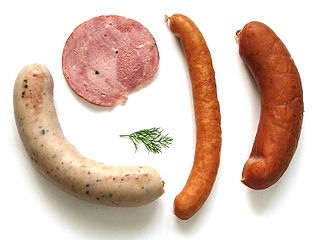
A sausage is a type of meat product usually made from ground meat—often pork, beef, or poultry—along with salt, spices and other flavourings. Other ingredients, such as grains or breadcrumbs, may be included as fillers or extenders.

Offal, also called variety meats, pluck or organ meats, is the internal organs of a butchered animal. The word does not refer to a particular list of edible organs, and these lists of organs vary with culture and region, but usually exclude skeletal muscle. Offal may also refer to the by-products of milled grains, such as corn or wheat.

Meatloaf is a dish of ground meat that has been combined with other ingredients and formed into the shape of a loaf, then baked or smoked. The final shape is either hand-formed on a baking tray, or pan-formed by cooking it in a loaf pan. It is usually made with ground beef, although ground lamb, pork, veal, venison, poultry, and seafood are also used, sometimes in combination. Vegetarian adaptations of meatloaf may use imitation meat or pulses.

White pudding, oatmeal pudding or mealy pudding is a meat dish popular in the British Isles.
Romanian cuisine is a diverse blend of different dishes from several traditions with which it has come into contact, but it also maintains its own character. It has been mainly influenced by Turkish but also a series of European cuisines in particular from the Balkan Peninsula and Hungarian cuisine as well as culinary elements stemming from the cuisines of Central Europe.

Peasant foods are dishes eaten by peasants, made from accessible and inexpensive ingredients.

Pennsylvania Dutch cuisine is the typical and traditional fare of the Pennsylvania Dutch. According to one writer, "If you had to make a short list of regions in the United States where regional food is actually consumed on a daily basis, the land of the Pennsylvania Dutch—in and around Lancaster County, Pennsylvania—would be at or near the top of that list," mainly because the area is a cultural enclave of Pennsylvania Dutch culture.
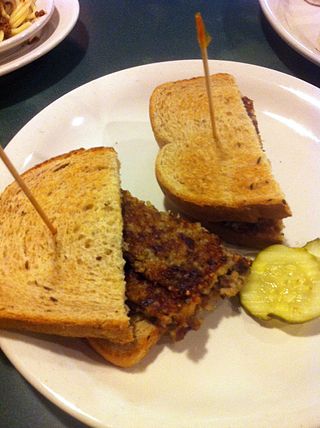
Goetta is a meat-and-grain sausage or mush of German inspiration that is popular in Metro Cincinnati. It is primarily composed of ground meat, steel-cut oats and spices. It was originally a dish meant to stretch out servings of meat over several meals to conserve money, and is a similar dish to scrapple and livermush, both also developed by German immigrants.

Balkenbrij is a traditional Dutch food that shares some of the characteristics of American scrapple. Traditionally, its preparation and consumption was an important economizing custom, especially for the rural poor. Particularly, it allowed farmers to use various less-desirable parts of pork, which were made more palatable by being added to a seasoned porridge of groats or flour. The closely related 'Panhas', 'Pannas' or 'Möppkenbrot' are widely known in the whole northwest of Germany; the last variety is a speciality of middle Westphalia and Rhineland.
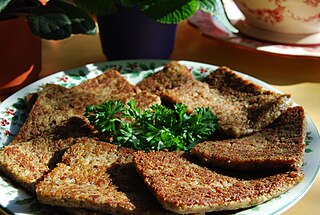
Livermush is a Southern United States pork food product prepared using pig liver, parts of pig heads, cornmeal and spices. It is a regional cuisine that is common in Western North Carolina. It is typically consumed as a breakfast and lunch food. It has been suggested that livermush derives from scrapple. By law in North Carolina, the product must consist of at least 30% pig liver. Several festivals exist in North Carolina that are dedicated to the food.
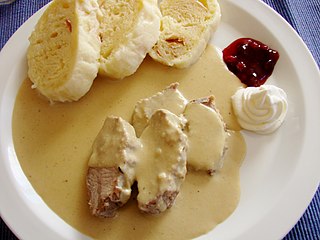
Czech cuisine has both influenced and been influenced by the cuisines of surrounding countries and nations. Many of the cakes and pastries that are popular in Central Europe originated within the Czech lands. Contemporary Czech cuisine is more meat-based than in previous periods; the current abundance of farmable meat has enriched its presence in regional cuisine. Traditionally, meat has been reserved for once-weekly consumption, typically on weekends.
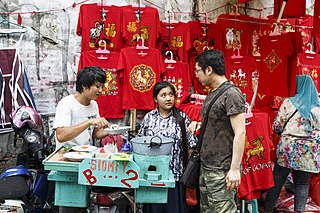
Chinese Indonesian cuisine is characterized by the mixture of Chinese with local Indonesian style. Chinese Indonesians, mostly descendant of Han ethnic Hokkien and Hakka speakers, brought their legacy of Chinese cuisine, and modified some of the dishes with the addition of Indonesian ingredients, such as kecap manis, palm sugar, peanut sauce, chili, santan and local spices to form a hybrid Chinese-Indonesian cuisine. Some of the dishes and cakes share the same style as in Malaysia and Singapore, known as Nyonya cuisine by the Peranakan.

Dinuguan is a Filipino savory stew usually of pork offal and/or meat simmered in a rich, spicy dark gravy of pig blood, garlic, chili, and vinegar.

Faggots are meatballs made from minced off-cuts and offal mixed with herbs and sometimes bread crumbs. It is a traditional dish in the United Kingdom, especially South and Mid Wales and the English Midlands.
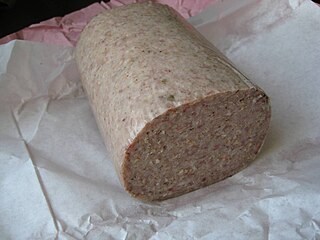
Knipp is a type of sausage made by mixing meat with grains (Grützwurst) related to Pinkel which comes from the Bremen and Lower Saxony regions of Germany.
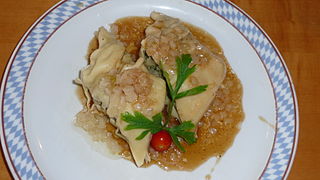
Swabian cuisine is native to Swabia, a region in southwestern Germany comprising great parts of Württemberg and the Bavarian part of Swabia. Swabian cuisine has a reputation for being rustic, but rich and hearty. Fresh egg pastas, soups, and sausages are among Swabia's best-known types of dishes, and Swabian cuisine tends to require broths or sauces; dishes are rarely "dry".

Embutido, or embotido, is a Philippine meatloaf made with ground pork and stuffed with hard-boiled eggs and sliced ham or various sausages. It is traditionally wrapped in aluminum foil and steamed, though it can also be baked.

Indonesian noodles are a significant aspect of Indonesian cuisine which is itself very diverse. Indonesian cuisine recognizes many types of noodles, with each region of the country often developing its own distinct recipes.


















